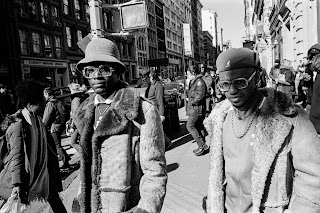people watching and street photography VI.
The Flâneur and the Aesthetic Appropriation of Urban Culture in Mid-19th-century Paris, Mary Gluck
Visual representations of the 1840s presented the flâneur
in black frock coat and top hat, with a cigar and a walking cane or
umbrella in hand, which signified the correct public apparel of the urban
bourgeoisie. He was always located on the boulevards, arcades, parks and cafes
of the city and that emphasized how unthinkable the flâneur was in
interior spaces such as salons and even theaters, unless it was the foyer where
he could observe the audience.
The essence of the flâneur as a cultural type
lay in the fact that his ‘publicness’ was not a neutral empirical fact but a
heroic aspiration, conceived in opposition to the pragmatic and moralistic
spirit of the age. In Baudelaire’s words, the flâneur was a visionary,
in search of ‘poetic and marvelous subjects’ and the ‘epic side of modern
life’, not apparent to ordinary mortals. The quintessential flâneur in
Baudelaire’s eyes was Honoré de Balzac, whom he characterized as ‘the most
heroic, the most extraordinary’ of all the fictional types he had given birth to.
The flâneur’s heroism took shape within the
conventions of bourgeois culture. His black frock coat mirrored the new
austerity of male attire characteristic of the modern age. As Philippe Perrot
and John Harvey have pointed out, the disappearance of color and fantasy from
the public clothing of bourgeois men in the early 19th century was culturally
over-determined. According to Perrot, it served to symbolize a new way of life,
based on ‘modesty, effort, propriety and “self-control”, which were the basis
of bourgeois “respectability”.
The flâneur succeeded in being both fully modern
and yet unquestionably heroic. But the flâneur’s heroism was not
identified with military valor or any overt public gestures. What he
accomplished was to render legible and transparent the bewildering heterogeneity
of urban life and to create a viable model for an epic imagination in modernity.
next
The Crimes of the Flaneur by Tom McDonough
Flânerie and the globalizing city by Kathryn Kramer & John Rennie Short


Comments
Post a Comment